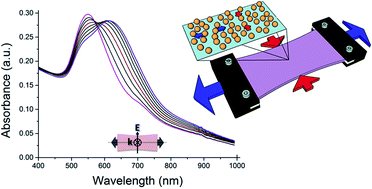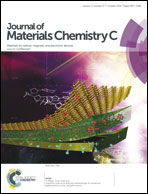Growing gold nanoparticles on a flexible substrate to enable simple mechanical control of their plasmonic coupling†
Abstract
A simple method is presented to control and trigger the coupling between plasmonic particles using both a growing process of gold nanoparticles (GNPs) and a mechanical strain applied to the elastomeric template where these GNPs are anchored. The large scale samples are prepared by first depositing and then further growing gold nanoparticles on a flexible PDMS tape. Upon stretching the tape the particles move further apart in the direction of the stretching and closer together in the direction perpendicular to it. The synergy between the controlled growth of GNPs and the mechanical strain, leads to a drastic shift of the plasmon band and a color change of the sample. Furthermore, the stretching by only a few percent of the amorphous and initially isotropic sample results in a strong polarization-dependent plasmon shift. At smaller gap sizes between neighboring particles, induced by stretching the PDMS tape, the plasmon shift strongly deviates from the behaviour expected considering the plasmon ruler equation. This shows that multipolar coupling effects significantly contribute to the observed shift. Overall, these results indicate that a macroscopic mechanical strain allows one to control the coupling and therefore the electromagnetic field at the nanoscale.


 Please wait while we load your content...
Please wait while we load your content...